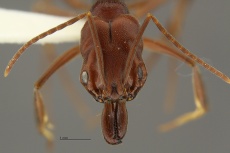Key to US Odontomachus species
Key to United States species of Odontomachus based on workers, modified from MacGown et al. (2014).
1
- Petiole with conspicuous transverse striae (Fig. A) => 2
- Petiole smooth, lacking transverse striae, or with at most, only a few feeble striae basally (Fig. B) => 3
2
- Large, HL usually greater than 2.5 mm, WL usually greater than 3.0 mm; transverse striae on petiolar node conspicuous anteriorly, laterally, and posterobasally, but reduced or lacking on remainder of posterior region; metasternum with paired, elongate, slender, spiniform processes present (Fig. A) (it may be necessary to remove one hind leg including coxa to see this character) (Gulf Coast) => Odontomachus haematodus
 Head of Odontomachus haematodus worker |
 Profile of Odontomachus haematodus worker |
- Smaller, HL usually less than 2.5 mm, WL usually less than 2.75 mm; petiole with coarser striae on the posterior side, finer striae basally on the sides and front; metasternum with notched ridge, but not projecting as elongate spiniform processes (Fig. B) (peninsular Florida) => Odontomachus ruginodis
 Head of Odontomachus ruginodis worker |
 Profile of Odontomachus ruginodis worker |
3
- Pubescence on first tergite of gaster extremely fine and dense, spaces between hairs less than 1/3 as wide as length of hairs (Fig. A) (Georgia to Mississippi) => Odontomachus brunneus
 Head of Odontomachus brunneus worker |
 Profile of Odontomachus brunneus worker |
- Pubescence on first tergite of gaster sparse, spaces between hairs at least 1/2 as wide as length of hairs (Fig. B) => 4
4
- Basalar lobe striate, ovate in shape (Fig. A) (endemic to sand ridges of south-central peninsular Florida) => Odontomachus relictus
 Head of Odontomachus relictus worker |
 Profile of Odontomachus relictus worker |
- Basalar lobe mostly smooth, spheroid (Fig. B) (west of the Mississippi River) => 5
5
- Large, HL > 2.5 mm, WL > 3.0 mm; propleurae almost entirely striate or otherwise roughened (Fig. A); cervical lobe of pronotum wider than long in dorsal view with width measured from the posterior inflection points; scapes long (SL/HW = 1.11-1.15); dorsomedian process of petiole in anterior view spiniform, long, thick at base, and poorly differentiated from rest of node (Fig. C) (Sonoran Desert, Arizona, Mexico) => Odontomachus desertorum
 Head of Odontomachus desertorum worker |
 Profile of Odontomachus desertorum worker |
- Smaller, HL ≤ 2.2 mm, WL ≤ 2.8 mm; propleurae almost entirely smooth and shining, with sculpture restricted to portions of lateral margins (Fig. B); cervical lobe of pronotum longer than wide in dorsal view with width measured from the posterior inflection points; scapes shorter (SL/HW = 0.99-1.07); dorsomedian process of petiole in anterior view either stoutly conical or spiniform, short, narrow at base, and strongly differentiated from rest of node (Fig. D, E) (Louisiana, southwest United States, north and central Mexico) => Odontomachus clarus
 Head of Odontomachus clarus worker |
 Profile of Odontomachus clarus worker |
References
- MacGown, J.A., Boudinot, B., Deyrup, M. & Sorger, D.M. 2014. A review of the Nearctic Odontomachus (Hymenoptera: Formicidae: Ponerinae) with a treatment of the males. Zootaxa 3802(4): 515-552.




